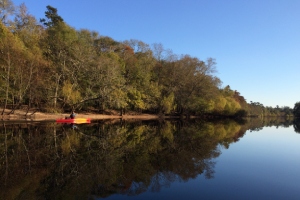Scenic Rivers - Overview

Program Overview
The Scenic Rivers Program is established by the South Carolina Scenic Rivers Act of 1989 and administered by the South Carolina Department of Natural Resources (SCDNR). The program purpose is to promote conservation of the state’s river heritage and protect the "unique or outstanding scenic, recreational, geologic, botanical, fish, wildlife, historic, or cultural values" of selected rivers or river segments in the state.
How does the program accomplish its purpose?
Provisions and directives of the Scenic Rivers Act include the following:
- Inventory and study of rivers to identify rivers with unique and outstanding values.
- Designation of scenic rivers through a process involving eligibility studies, public meetings, agency approvals, and legislative action.
- Establish advisory councils on designated State Scenic Rivers to assist and advise SCDNR on protection and management of the rivers.
- Develop and implement scenic river management plans in partnership with the advisory councils and local community.
- Protection of river-bordering (riparian) lands though purchase or acceptance of land donations. The Scenic Rivers Act provides specific tax incentives for land donations to the state.
How do I participate as a landowner?
As mentioned, the Scenic Rivers Program is a voluntary, cooperative program to promote responsible use and stewardship of the river. Additionally, we acknowledge there is a legacy of good, responsible stewardship among many landowners along South Carolina rivers. It is that stewardship legacy we want to support and see continued.
Landowners along a state designated scenic river are not obligated to participate in the program and their land is not affected by additional regulations of the state as result of the designation. Landowners who do wish to participate may serve as a member of the advisory council. Landowners could also commit to managing their property to protect and enhance the natural and scenic qualities of the river by following the Scenic River Program BMPs for riparian lands. Landowners could choose to apply permanent protections to their property through a conservation easement, which is a legally binding agreement to limit development on the property that usually provides tax benefits to the owner.
What is a scenic river management plan and who writes it?
A scenic river management plan contains several components; it contains an inventory of the existing land uses and provides an assessment of the scenic, recreational, geologic, botanical, fish, wildlife, historic, environmental, and cultural attributes of the river corridor. It also includes an overview of problems in the river corridor and recommends a plan of action to solve those problems. Finally, the plan recommends land management practices that are compatible with protection of the river. The management plan is written by the scenic river advisory council, which is comprised of landowners along the river and interested members of the public. The plan should consider and respect the interests and rights of private property owners.
What is a Scenic River Advisory Council?
A scenic river advisory council is a six-to-ten-member committee composed of river-bordering landowners and representatives of community interest groups. Its job is to assist and advise the SCDNR concerning protection and management of the scenic river. By law, the majority of members on an advisory council must be landowners along the designated scenic river. For every State Scenic River, an advisory council is appointed by the Executive Director of the SCDNR and is chaired by a staff member from the SCDNR's Scenic Rivers Program. The advisory council is appointed after a river has been designated a State Scenic River by the South Carolina General Assembly. The initial task of an advisory council is to draft a management plan for the river.
What are the steps in the scenic river designation process?
The steps in the designation process are as follows:
- First, a local request for scenic river designation is made, and then the SCDNR conducts a scenic river eligibility study. The staff studies and evaluates the scenic, natural, cultural, and recreational values of the river corridor and its land use conditions. Findings from the eligibility study provide the information needed to support a State Scenic River designation.
- Second, riparian landowners and the public are notified of the proposal and invited to public meetings to ask questions and offer input.
- Third, each county council of the river-bordering counties is notified and asked to offer a resolution of support for the scenic river proposal.
- Finally, after the SCDNR Board reviews and approves the proposal, a bill is introduced in the General Assembly. When the bill passes and the Governor signs it into law, a State Scenic River is officially designated. After the designation is completed, the SCDNR will establish a scenic river advisory council.
